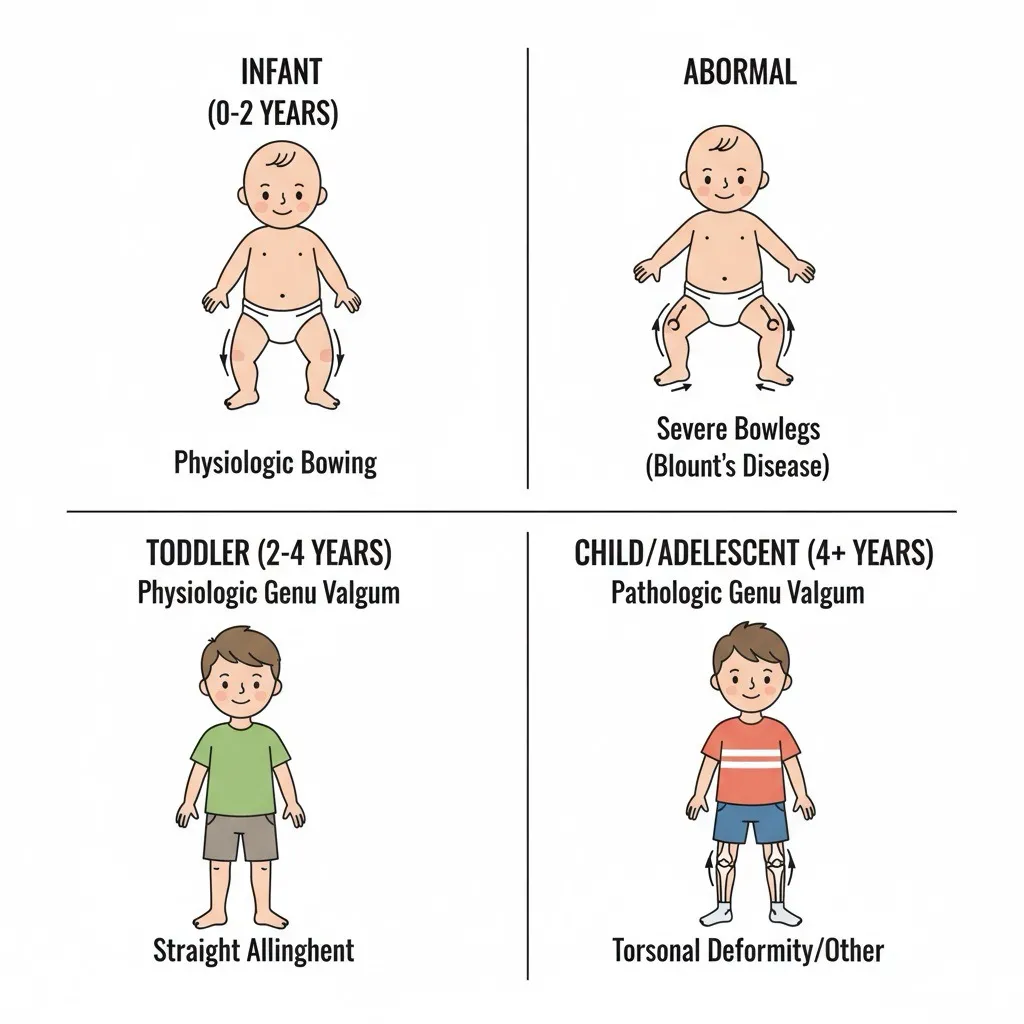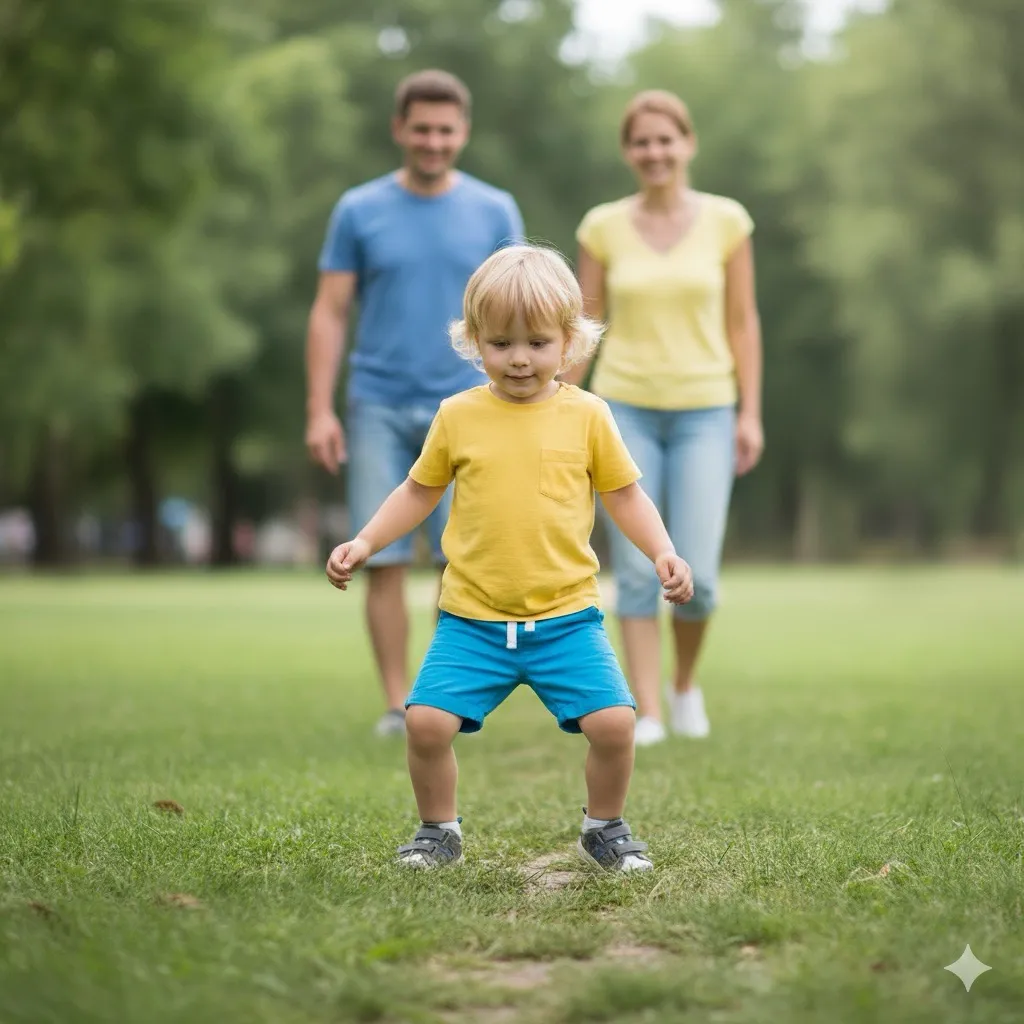Table of Contents
Why Parents Look for Natural Solutions
When parents first notice bow legs in their child, it’s common to hope that the condition will correct itself with time, exercise, or simple remedies. Relatives and well-wishers often advise “wait and watch,” “give more calcium,” or “massage the legs daily.” While some of these suggestions come from experience, others are myths that can delay proper treatment.
This blog will separate correcting bow legs naturally myths from medical facts—so you know when bow legs are part of normal growth, and when medical help is necessary.
Understanding Bow Legs in Children
What Are Bow Legs?
Bow legs (medical term: genu varum) occur when the legs curve outward at the knees, creating a gap between them even when the ankles touch.
Normal vs Abnormal Bow Legs
- Normal: In toddlers under 2 years old, bowing is often a part of natural development and usually corrects on its own.
- Abnormal: Persistent or worsening bowing after age 3, or bowing accompanied by pain, limping, or difficulty walking, may indicate an underlying condition such as Blount’s disease or rickets.

Common Myths About Correcting Bow Legs
Myth 1: “Bow legs always straighten out naturally.”
Fact: While mild bowing is normal in toddlers, if it continues beyond age 3 or gets worse, natural correction is unlikely. Early evaluation is key.
Myth 2: “Massaging or stretching the legs can fix bow legs.”
Fact: No amount of massage, stretching, or traditional remedies can realign bones if the growth plate is causing the deformity. Massages may improve circulation, but won’t correct bone alignment.
Myth 3: “Extra calcium or vitamins will make the legs straight.”
Fact: Nutritional support is important, especially in cases of rickets. But in structural deformities like Blount’s disease, vitamins alone won’t correct the curve. Medical guidance is needed.
Myth 4: “Special shoes or braces can cure bow legs in all cases.”
Fact: Braces may help in select conditions like very early Blount’s disease. But for most cases, especially after age 3, braces alone are rarely effective.
Myth 5: “Surgery for bow legs is always major and risky.”
Fact: Modern options like guided growth surgery are minimally invasive, safe, and use the child’s own growth to straighten the legs gradually—avoiding large cuts or long recovery times.
Medical Facts Parents Should Know
1. Age Matters
- Natural correction is expected only up to age 2–3.
- After that, persistent bowing needs a medical assessment.
2. Diagnosis Is Crucial
- X-rays and clinical evaluation help determine whether bowed legs are part of natural growth or due to an underlying disease.
3. Early Treatment = Better Results
- Guided growth surgery works best when growth plates are still open (between ages 3–14).
- Delayed correction can lead to permanent deformity, early arthritis, and joint pain.
4. Non-Surgical vs Surgical Options
- Observation and nutritional correction (for rickets) may be enough in mild cases.
- Significant or progressive bowing often needs guided growth surgery or, in older children, osteotomy.
When Should Parents Seek Medical Advice?
- Bow legs worsening after age 3
- Unequal bowing between legs
- Pain, limping, or difficulty running
- Family history of bone deformities
- Concerns about appearance affecting confidence

Dr. Divya Ahuja’s Approach: Balancing Reassurance and Expertise
Dr. Divya Ahuja, an expert in pediatric limb deformities and guided growth surgery, understands both the worries of parents and the science of bone growth. His approach:
- Careful evaluation to distinguish normal from abnormal bowing
- Honest guidance on whether observation, nutrition, or surgery is needed
- Minimally invasive correction when necessary, with focus on quick recovery and long-term joint health
Our Clinical Locations
Tap a location to view timings, contact, and map.
Broadway Healthcare, Dadar East
Broadway Healthcare, Dadar East
Clinic Info
- 📍 Broadway Healthcare, Dadar East, Mumbai
- 🕒 Wednesdays · 10:00 AM – 12:00 NOON
- 📞 Appointments: +91 93213 17227
Sweet Clinics, Vashi, Navi Mumbai
Sweet Clinics, Vashi, Navi Mumbai
Clinic Info
- 📍 Sweet Clinics, Vashi, Navi Mumbai
- 🕒 Fridays · 10:00 AM – 12:00 NOON
- 📞 Appointments: +91 93213 17227
Heal Well Speciality Clinic, Thane West
Heal Well Speciality Clinic, Thane West
Clinic & OPD Info
- 📍 Heal Well Speciality Clinic, Thane West
- 🕒 Every Wednesday 10:00 AM – 11:00 AM
- 📞 Appointments: +91 81691 04438
Mangal Anand Hospital, Chembur Mumbai
Mangal Anand Hospital, Chembur Mumbai
Clinic & OPD Info
- 📍 Mangal Anand Hospital, Chembur Mumbai
- 🕒 Monday, Wednesday, Friday 03-07 PM, Thursday 06-07 PM, Free OPD Saturday 02-04 PM
- 📞 Appointments: +91 70212 18182
Conclusion: Myths Delay, Facts Heal
Correcting bow legs is not about home remedies or waiting forever. It’s about knowing the facts, acting early, and choosing the safest medical option. With Dr. Divya Ahuja’s expertise, families in Mumbai and Navi Mumbai can be confident that their child will get the right care at the right time.
FAQs
Can bow legs be corrected naturally?
Often, yes—in infants and toddlers. Physiologic bowing is common up to ~2 years and usually straightens on its own by ages 3–4 without treatment. Past that age, persistent or worsening bowing should be assessed.
Do bow legs always need treatment?
No. Treat only when there’s pain, progressive deformity, asymmetry, limp, functional limits, short stature, or an underlying disease (rickets, Blount disease, skeletal dysplasia). Cosmetic concerns alone are a personal choice.
Can vitamin D fix bow legs?
It can help if the cause is rickets (vitamin D ± calcium deficiency). In those cases, correcting the deficiency lets bones mineralize and often improves alignment in growing children. It won’t straighten structural bowing in teens/adults by itself.
Is it too late to treat bow legs as an adult?
No. Adults can be treated, but not with growth-guided methods. Options include bracing for symptoms, targeted physio, and corrective osteotomy (bone realignment surgery) when deformity causes pain, arthritis risk, or gait issues.
At what age do normal bow legs usually correct?
Birth–18 months: bowed alignment is common.
~2 years: legs approach straight.
~3–4 years: mild knock-knee phase is common.
~7–8 years adult-like alignment.
Are bow-legged people more athletic?
Not inherently. Many athletes have neutral alignment. Some sports tolerate or even incidentally select for certain builds, but bowing doesn’t guarantee better speed, power, or agility. Training, conditioning, and technique matter far more.
Why do some footballers look bow-legged?
Several reasons: natural alignment variation, muscle development around the thighs/calf that accentuates the gap, and camera angles. It isn’t caused by playing football, and most have normal biomechanics.
Does fixing bow legs make you taller?
Surgery can slightly increase measured height if a large varus angle is corrected (straightening increases vertical stature by a small amount). Expect millimeters to a couple of centimeters at most, not a dramatic change.
Are bow legs genetic?
Alignment has a heritable component. Family patterns exist, but many cases are physiologic (normal variation) or due to nutritional/metabolic causes. A family history raises likelihood, not certainty.
Are bow legs allowed in the army?
Standards vary by country and branch. Generally, mild, asymptomatic bowing is acceptable; significant deformity affecting running, marching, or load-bearing can be disqualifying. In India, fitness boards consider function and severity—get an ortho assessment before applying.
Who is most at risk for rickets-related bowing?
Rapidly growing infants/toddlers with low sun exposure
Diets low in vitamin D and calcium
Exclusive breastfeeding without vitamin D supplementation (in some cases)
Darker skin living at higher latitudes
Malabsorption (celiac, IBD) or chronic kidney/liver disease
Can insoles or braces correct bow legs?
Insoles don’t realign bones. They may ease knee/foot pain by improving load distribution. Bracing can help young children with specific conditions (e.g., early Blount disease) but won’t correct established bony varus in teens/adults.
What happens if bow legs go untreated?
If mild and physiologic, nothing. If moderate/severe, risks include medial knee overload, meniscus wear, early osteoarthritis, IT-band/hamstring strain, and gait inefficiency. Progression depends on angle, weight, activity, and cause.
Which muscles tend to be weak or tight in a bow-legged posture?
Common patterns (varies by person):
Weak/underused: hip abductors (gluteus medius), external rotators, core stabilizers.
Tight/overused: adductors, hamstrings, iliotibial band, calf.
A physio can tailor a program focusing on hip abductor strength, single-leg control, and mobility.
How can I make bow legs less noticeable without surgery?
Physio program: hip/glute strengthening, neuromuscular control, weight management to reduce knee load.
Footwear/insoles: for comfort and load sharing (cosmetic effect minimal).
Style hacks: straight/relaxed-fit trousers, darker colors, avoid highly tapered legs.
Activity choices: low-impact cardio (cycling, swimming) plus strength training.









